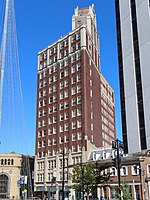Rochester Savings Bank

Rochester Savings Bank is a historic bank building located at Rochester in Monroe County, New York. It is a four-story, V-shaped structure, sheathed in Kato stone from Minnesota. It was designed by McKim, Mead and White and built in 1927 to house the Rochester Savings Bank. The building's banking room interior features murals painted by noted artist Ezra Winter.It was listed on the National Register of Historic Places in 1972.In 2011, the building was acquired by a group called Rochester Historic Ventures, which then set out to seek occupants that would allow the building to return to public use.In October 2012, Rochester Institute of Technology announced the creation of a Center for Urban Entrepreneurship, to be housed in the Rochester Savings Bank building. The university plans to ultimately spend $3–5 million on renovations, eventually resulting in a multidisciplinary center and multiuse venue for RIT students.In 2016 after a lengthy renovation of the building Center for Urban Entrepreneurship by RIT opened in the building.
Excerpt from the Wikipedia article Rochester Savings Bank (License: CC BY-SA 3.0, Authors, Images).Rochester Savings Bank
Franklin Street, City of Rochester
Geographical coordinates (GPS) Address Nearby Places Show on map
Geographical coordinates (GPS)
| Latitude | Longitude |
|---|---|
| N 43.158611111111 ° | E -77.605 ° |
Address
40 Franklin St.
Franklin Street 40
14604 City of Rochester
New York, United States
Open on Google Maps










